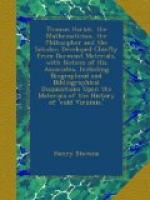These three thin folio volumes of great rarity are models of typographic beauty. They manifestly served as the model for printing Hariot’s Algebra in 1631. The set here described (the three bound in one volume), Prince Henry’s own copies, bearing his arms and the Prince of Wales’ feathers, is preserved in the British Museum, press-marked 530, m. 10.
Thus Vieta’s method appears to have been given to the world in three instalments between 1591 and 1600, while the author himself died in 1603. It was probably in reference to one or both of these works that Lower gently reproached Hariot for having allowed himself to be anticipated in the public announcement of his discoveries in Algebra by Vieta. It has already been seen, on page 101 above, what Torperley, the friend of Vieta, wrote of his two masters in 1602, and also, on page 121, what Lower wrote to Hariot in 1610.
One is forced, therefore, to the conclusion that by 1600, if not some time before, Hariot had completed his method in Algebra, and distributed his well known problems to his admiring scholars. It has also been seen how, from 1603 to the day of his death, he was occupied in many other absorbing matters connected with Raleigh and Percy. Yet he may have felt, as Lower expressed it, that when he surveyed his storehouse of inventions this one of Algebra might seem in ’ comparison of manie others smal or of no value.’ The matter is introduced here mainly because certain foreign writers,rebutting Wallis’s patriotic claims in behalf of Hariot, have not only accused Hariot of appropriating Vieta’s rights, but they even describe the distinguished English mathematician as working on the ’ Cartesian Method.’ While the truth appears to be that Hariot’s method in Algebra, though not published for more than thirty years after its invention, must date from a time when Descartes was scarcely four years old.
On the other hand, on looking into Descartes’ great and original work on geometry, first published in 1637, six years after Hariot’s Algebra first saw the light in print, one is not disposed to accuse the great philosopher of plagiarism because in working out his problems of great novelty in reference to geometrical curves he employed any systems of notation and calculation in algebra (Hariot’s among the others) that happened to be before the world. The point or essence of Descartes’ work was geometry and not algebra. Therefore, in climbing to his loft, he was perfectly justified in using the ladder which Hariot had left, as it was then in general use, and was only an incidental aid in his independent calculations, especially as the fame of his great mathematical brother was well established, and he had been already sixteen years in St Christopher’s. Vieta therefore had manifestly no just reason to complain, and Descartes stands acquitted.




